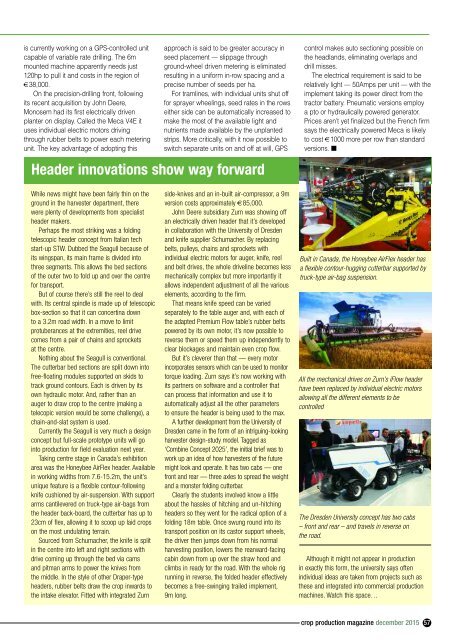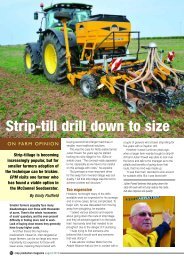Create successful ePaper yourself
Turn your PDF publications into a flip-book with our unique Google optimized e-Paper software.
is currently working on a GPS-controlled unit<br />
capable of variable rate drilling. The 6m<br />
mounted machine apparently needs just<br />
120hp to pull it and costs in the region of<br />
€38,000.<br />
On the precision-drilling front, following<br />
its recent acquisition by John Deere,<br />
Monosem had its first electrically driven<br />
planter on display. Called the Meca V4E it<br />
uses individual electric motors driving<br />
through rubber belts to power each metering<br />
unit. The key advantage of adopting <strong>this</strong><br />
approach is said to be greater accuracy in<br />
seed placement –– slippage through<br />
ground-wheel driven metering is eliminated<br />
resulting in a uniform in-row spacing and a<br />
precise number of seeds per ha.<br />
For tramlines, with individual units shut off<br />
for sprayer wheelings, seed rates in the rows<br />
either side can be automatically increased to<br />
make the most of the available light and<br />
nutrients made available by the unplanted<br />
strips. More critically, with it now possible to<br />
switch separate units on and off at will, GPS<br />
Header innovations show way forward<br />
control makes auto sectioning possible on<br />
the headlands, eliminating overlaps and<br />
drill misses.<br />
The electrical requirement is said to be<br />
relatively light –– 50Amps per unit –– with the<br />
implement taking its power direct from the<br />
tractor battery. Pneumatic versions employ<br />
a pto or hydraulically powered generator.<br />
Prices aren’t yet finalized but the French firm<br />
says the electrically powered Meca is likely<br />
to cost €1000 more per row than standard<br />
versions. ■<br />
While news might have been fairly thin on the<br />
ground in the harvester department, there<br />
were plenty of developments from specialist<br />
header makers.<br />
Perhaps the most striking was a folding<br />
telescopic header concept from Italian tech<br />
start-up STW. Dubbed the Seagull because of<br />
its wingspan, its main frame is divided into<br />
three segments. This allows the bed sections<br />
of the outer two to fold up and over the centre<br />
for transport.<br />
But of course there’s still the reel to deal<br />
with. Its central spindle is made up of telescopic<br />
box-section so that it can concertina down<br />
to a 3.2m road width. <strong>In</strong> a move to limit<br />
protuberances at the extremities, reel drive<br />
comes from a pair of chains and sprockets<br />
at the centre.<br />
Nothing about the Seagull is conventional.<br />
The cutterbar bed sections are split down into<br />
free-floating modules supported on skids to<br />
track ground contours. Each is driven by its<br />
own hydraulic motor. And, rather than an<br />
auger to draw crop to the centre (making a<br />
telecopic version would be some challenge), a<br />
chain-and-slat system is used.<br />
Currently the Seagull is very much a design<br />
concept but full-scale prototype units will go<br />
into production for field evaluation next year.<br />
Taking centre stage in Canada’s exhibition<br />
area was the Honeybee AirFlex header. Available<br />
in working widths from 7.6-15.2m, the unit’s<br />
unique feature is a flexible contour-following<br />
knife cushioned by air-suspension. With support<br />
arms cantilevered on truck-type air-bags from<br />
the header back-board, the cutterbar has up to<br />
23cm of flex, allowing it to scoop up laid crops<br />
on the most undulating terrain.<br />
Sourced from Schumacher, the knife is split<br />
in the centre into left and right sections with<br />
drive coming up through the bed via cams<br />
and pitman arms to power the knives from<br />
the middle. <strong>In</strong> the style of other Draper-type<br />
headers, rubber belts draw the crop inwards to<br />
the intake elevator. Fitted with integrated Zurn<br />
side-knives and an in-built air-compressor, a 9m<br />
version costs approximately €85,000.<br />
John Deere subsidiary Zurn was showing off<br />
an electrically driven header that it’s developed<br />
in collaboration with the University of Dresden<br />
and knife supplier Schumacher. By replacing<br />
belts, pulleys, chains and sprockets with<br />
individual electric motors for auger, knife, reel<br />
and belt drives, the whole driveline becomes less<br />
mechanically complex but more importantly it<br />
allows independent adjustment of all the various<br />
elements, according to the firm.<br />
That means knife speed can be varied<br />
separately to the table auger and, with each of<br />
the adapted Premium Flow table’s rubber belts<br />
powered by its own motor, it’s now possible to<br />
reverse them or speed them up independently to<br />
clear blockages and maintain even crop flow.<br />
But it’s cleverer than that –– every motor<br />
incorporates sensors which can be used to monitor<br />
torque loading. Zurn says it’s now working with<br />
its partners on software and a controller that<br />
can process that information and use it to<br />
automatically adjust all the other parameters<br />
to ensure the header is being used to the max.<br />
A further development from the University of<br />
Dresden came in the form of an intriguing-looking<br />
harvester design-study model. Tagged as<br />
‘Combine Concept 2025’, the initial brief was to<br />
work up an idea of how harvesters of the future<br />
might look and operate. It has two cabs –– one<br />
front and rear –– three axles to spread the weight<br />
and a monster folding cutterbar.<br />
Clearly the students involved know a little<br />
about the hassles of hitching and un-hitching<br />
headers so they went for the radical option of a<br />
folding 18m table. Once swung round into its<br />
transport position on its castor support wheels,<br />
the driver then jumps down from his normal<br />
harvesting position, lowers the rearward-facing<br />
cabin down from up over the straw hood and<br />
climbs in ready for the road. With the whole rig<br />
running in reverse, the folded header effectively<br />
becomes a free-swinging trailed implement,<br />
9m long.<br />
Built in Canada, the Honeybee AirFlex header has<br />
a flexible contour-hugging cutterbar supported by<br />
truck-type air-bag suspension.<br />
All the mechanical drives on Zurn’s iFlow header<br />
have been replaced by individual electric motors<br />
allowing all the different elements to be<br />
controlled<br />
The Dresden University concept has two cabs<br />
– front and rear – and travels in reverse on<br />
the road.<br />
Although it might not appear in production<br />
in exactly <strong>this</strong> form, the university says often<br />
individual ideas are taken from projects such as<br />
these and integrated into commercial production<br />
machines. Watch <strong>this</strong> space…<br />
crop production magazine december 2015 57



